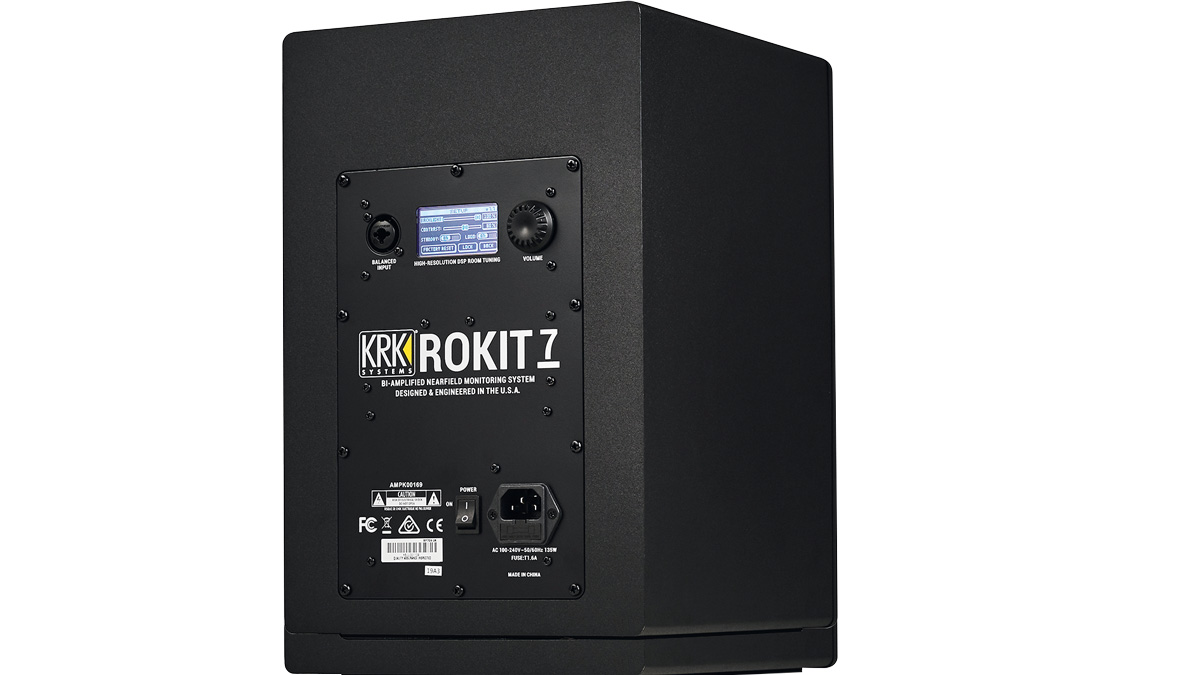MusicRadar Verdict
With their punchy delivery and abundance of EQ tweaking options, the RP7 monitors are Rokit's best yet, offering plenty of power at an accessible price.
Pros
- +
Front port lets you position them close to the wall.
- +
Excellent performance.
- +
Plenty of range in the EQ.
- +
Isolation and mounting pad is integrated.
Cons
- -
Inconvenient positioning of the LCD menu.
MusicRadar's got your back
Long-established and much loved, KRK's Rokit line of powered studio monitors has undergone a major revision with and now comprises four monitors built around 5”, 7”, 8” and 10” LF drivers.
Aesthetically, the new Rokits are chips off the old block, featuring the trademark yellow Kevlar LF cones, with the new models also having yellow Kevlar HF units as well. The amplification is now class D, as opposed to the class AB design previously used, and there’s also a brickwall limiter.
- The best budget studio monitors: affordable studio speakers
Our review models is the Rokit RP7 – a new size for monitors in this series with a 7” LF driver joining the 1” tweeter. Previously the mid-sized nearfield used a 6” LF driver, but still, at 339mm high, the RP7 retains the compact enclosure, and is only marginally taller than its predecessor.
It still fits comfortably within a typical desktop or mixer-based setup. A new low-resonance design, the yellow Rokit logo (there’s now an embossed logo on the bass port) has been removed from the enclosure. There's a new look baffle, too, with a shaped letterbox bass port giving the RP7 a very slick professional look.

On the underside of the monitor you will find a thin high-density iso-foam pad. This not only helps with isolation, it provides some crucial table-top grip. On the rear of the unit there is a balanced input via a combo XLR/TRS socket, the power inlet and on/off switch.
The KRK logo on the front of the speaker is backlit when the monitors are powered on. The features continue... There's a DSP-driven EQ and menu system that is controlled via an LCD and data encoder on the rear panel. Use this to fix the room correction EQ and monitor level. You can also use it to adjust the standby mode and the front panel logo backlight, which can be on, dimmed or off completely.
There is a 2-band EQ with five fixed settings per band – a total of 25 combinations. Specifically designed for room correction, these include typical shelving adjustments at 60Hz and 10kHz. If you feel confident making more extensive adjustments, there are also peak options at both 200Hz and 3.5kHz.
Want all the hottest music and gear news, reviews, deals, features and more, direct to your inbox? Sign up here.
Select your settings and the LCD displays an EQ curve so you know where you are tonally. Our only bugbear of note is the LCD's positioning. But once we turned one monitor round we were happy, matching the settings on the other one.
The default settings are pretty punchy. While this is great for capturing the vibe on a session, they are less suited to mixing. That required some adjustments, and we set the low shelf (60Hz) at -3dB.
The RP7's mid range sounds a bit reserved for my tastes. Ultimately, we plumped for a moderate EQ boost (+1dB at 3.5kHz and 10kHz). It is to the RP7's credit that we have the option to make these adjustments, and there’s also a handy iOS and Android app if you’re in need of some help with setup. They will help you with orientation and also analyse pink noise so your EQ adjustments are more effective.
The Rokit RP7 is a very decent monitor. Overall, it is well-built, and there are more than enough options for tweaking the setup so that the sonics are optimised for the room and, crucially, for your own personal taste.
MusicRadar verdict: With their punchy delivery and abundance of EQ tweaking options, the RP7 monitors are Rokit's best yet, offering plenty of power at an accessible price.
- Our pick of the best audio interfaces for music production
- The best guitar amps
- The best acoustic guitars right now
- Explore the best electric guitars
- The best electronic drum kits for all levels and budgets
- These are the best MIDI keyboards you can buy
- The best laptops for music production
- The best iPads for musicians and producers
Jon is a London based platinum award winning mixer, producer, composer and club remixer with a diverse CV that spans dance, pop, rock and music for media. He’s also a long term contributor to MusicRadar's music technology tutorials and reviews. Whether working alone or collaborating he usually handles final mixdowns, so you’ll also find MusicRadar peppered with his handy mixing tips.

